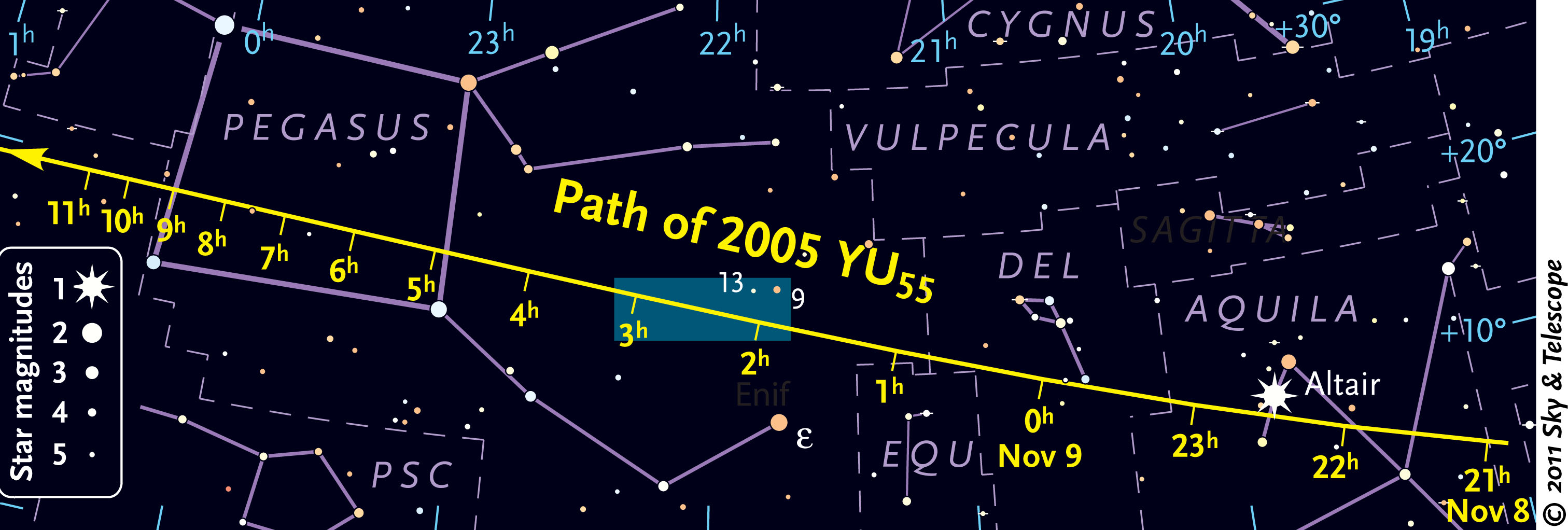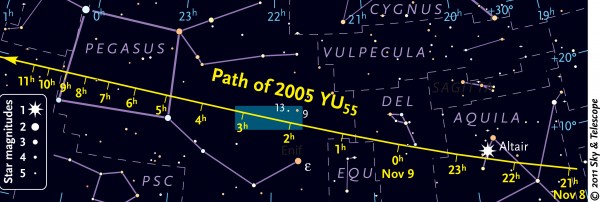2005 YU55 – A quick guide for skywatchers

Those of us without access to the world's biggest radio telescopes still have a chance to spot 2005 YU55 as it zips past Earth. The asteroid will be brightest in the sky a few hours after its closest approach and should be visible with decent equipment under clear, dark skies.
Here is a few facts and guides for skywatch enthusiasts:
TIME
23:28 UTC / 6:28 p.m. EST,/ 3:28 PST
For easier calculation of your time zone and time codes visit GMT Slider or go to WorldClock Timezones
DISTANCE
324,600 kilometers (201,700 miles) as measured from the center of Earth
about 0.85 times the distance from the moon to Earth
LOCATION
The pass's track is especially favorable for western Europe and North America
Asteroid will traverse the 70° of sky eastward from Aquila to central Pegasus in just 10 hours, clipping along at 7 arcseconds per second
The coordinates of 2005 YU55 can be looked up at JPL’s Solar System Dynamics website
You can also check detailed finder chart by Sky&Telescope
JPL Small-Body Database Browser (2005 YU55)
EQUIPMENT NEEDED
The asteroid will be brightest in the sky a few hours after its closest approach and should be visible with telescope if it has an aperture of at least 6 to 8 inches.
Don't forget it's nearly full Moon so you will fighting light probably

At the point of closest approach, the space rock will be traveling at about 46,671 km (29,000 mph) with distance about 324,600 kilometers (201,700 miles) from Earth — closer than the moon, which orbits 384,499 km (238,864 miles) from us on average. The asteroid will approach Earth from the sunward direction, so it will be a daylight object until just before the time of closest approach. A few hours later 2005 YU55 should reach a visual magnitude of 11.1, putting it within reach of backyard telescopes with apertures of at least 6 inches under fairly dark skies. Astronomers have issued a call for advanced amateurs who are set up to do precision photometry with at least a 10- or 12-inch scope.
LIVE WEBCASTS
For all those who don't own telescope the best way is to tune into one of live webcast via Internet.
2005 YU55 LIVE WEBCAST @ SLOOH SPACE CAMERA
2005 YU55 LIVE WEBCAST @ BELLATRIX OBSERVATORY's VIRTUAL TELESCOPE

I was pleased to see your sky map of YU55 but wondered if you could ass distance from earth to the map.
This would be interesting data for watchers.
This is great information! My team and I just got a photo of the asteroid, but it doesn’t look normal. We took the picture at 8:35pm MST (when the asteroid was at its closest) and used a 3 minute exposure. We were expecting a streak but got more of a dotted-line. If anyone knows how to explain this, my professor would love to hear it!
Check out our photo here: http://antifacts.com/?p=122
Thanks,
Ryan